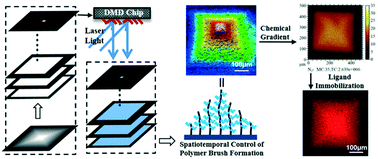Spatiotemporal control of polymer brush formation through photoinduced radical polymerization regulated by DMD light modulation†
Abstract
Spatially arranged polymer brushes provide the essential capability of precisely regulating the surface physicochemical and functional properties of various substrates. A novel and flexible polymer brush patterning methodology, which is based on employing a digital mirror device (DMD)-based light modulation technique to spatiotemporally regulate a surface-initiated photoinduced atom transfer radical polymerization (photo-ATRP) process, is presented. Various characterization techniques confirm that the spatially and/or temporally controlled brush formation results in complex PEG-derived brush patterns in accordance with a customized digital image design. A series of step-and-exposure strategies, including in situ multiple exposure, dynamic multiple exposure and dynamic sequential exposure, are developed to implement spatiotemporal regulation of the photo-ATRP process, leading to complex patterned and gradient brushes featuring binary functionalities, pyramid nanostructures and radial directional chemical gradients. Moreover, tunable and radial directional concentration gradients of various biomacromolecules (e.g., streptavidin) are obtained through preparation of height gradients of azido-functionalized brushes and subsequent orthogonal chemical activation aimed at specific protein immobilization. Finally, a unidirectional concentration gradient of fibronectin, surrounded by non-fouling PEG brushes, is fabricated and applied for human umbilical vein endothelial cell (HUVEC) adhesion experiments, whose preliminary results indicate gradient-dependent cell adhesion behavior in response to the concentration gradient of fibronectin. The presented fabrication technique could be integrated with microfluidic devices for sensors and bio-reactors, paving the way for novel approaches for lab-on-a-chip technologies.



 Please wait while we load your content...
Please wait while we load your content...